The peak harvest season for peaches is a hectic and exciting time in Georgia. When crop yields are abundant, the Georgia peach industry produces over 130 million pounds of fruit per year! So peach season is a very big deal and a huge source of essential income for the state with peach in its nickname. But when is peak timing for the juiciest harvest in the Peach State? Find out the sweet details below, where we discuss how peach season in Georgia produces some of the juiciest fruit in the US. We’ll also look at popular peach varieties and the secret behind why around 1.6 million peach trees thrive in Georgia’s climate.
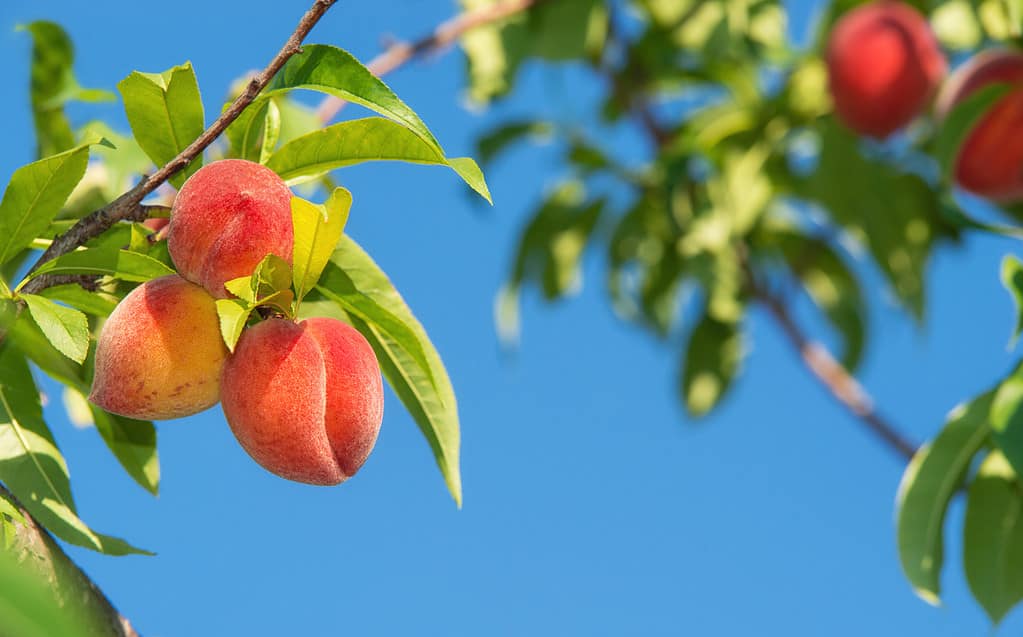
The peak time to harvest peaches in Georgia is in June and July.
©Leena Robinson/Shutterstock.com
When is the best time to pick peaches in Georgia?
The peach season in Georgia typically begins in mid-May and lasts through August. The specific harvest timing can vary depending on the peach variety, the climate, and the orchard’s growing region. Some peach varieties, like Red Haven, may be ripe in May, but the peak harvest is usually in June and July.
Sometimes Mother Nature has other plans.
The 2023 growing season was a debilitating one for Georgia peach farmers. So the fruit yields during the 2023 peach season are significantly smaller. Why? Keep reading to find out!
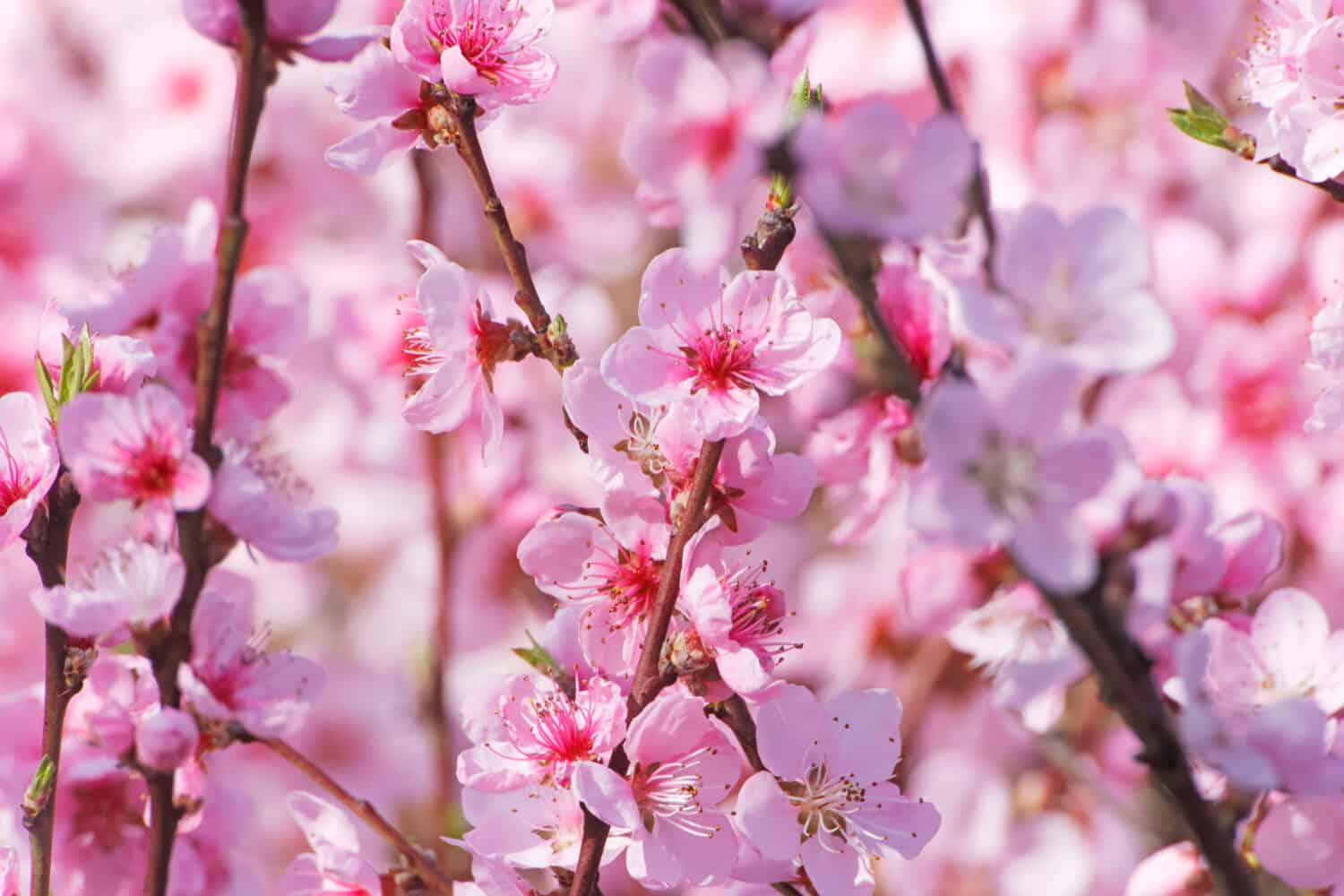
Early frost can kill the spring blossoms on a peach tree.
©Marc Stephan/Shutterstock.com
Why was 2023 a bad year for peach crops?
Abnormally high winter temperatures and two bouts of frost in mid-March destroyed a high percentage of Georgia peach crops in 2023. According to Specialty Crop Industry, the warm weather made peach trees bloom too early. And then most of the blooms were lost to frost.
These weather events caused widespread peach shortages across the Southeast US, but Georgia crops were hit especially hard. As a result, Georgia crop yields are significantly smaller in 2023 compared to recent years.
How long have they grown peaches in Georgia?
The peach season in Georgia has a long and prosperous history. Though these fruits aren’t native to North America (they come from Asia), peaches became a crop in Georgia in the 1800s. Later, commercial production of Georgia peaches began in the mid-1900s. Georgia soon became such an impressive pioneer in the commercial peach industry that it adopted the nickname “The Peach State.”
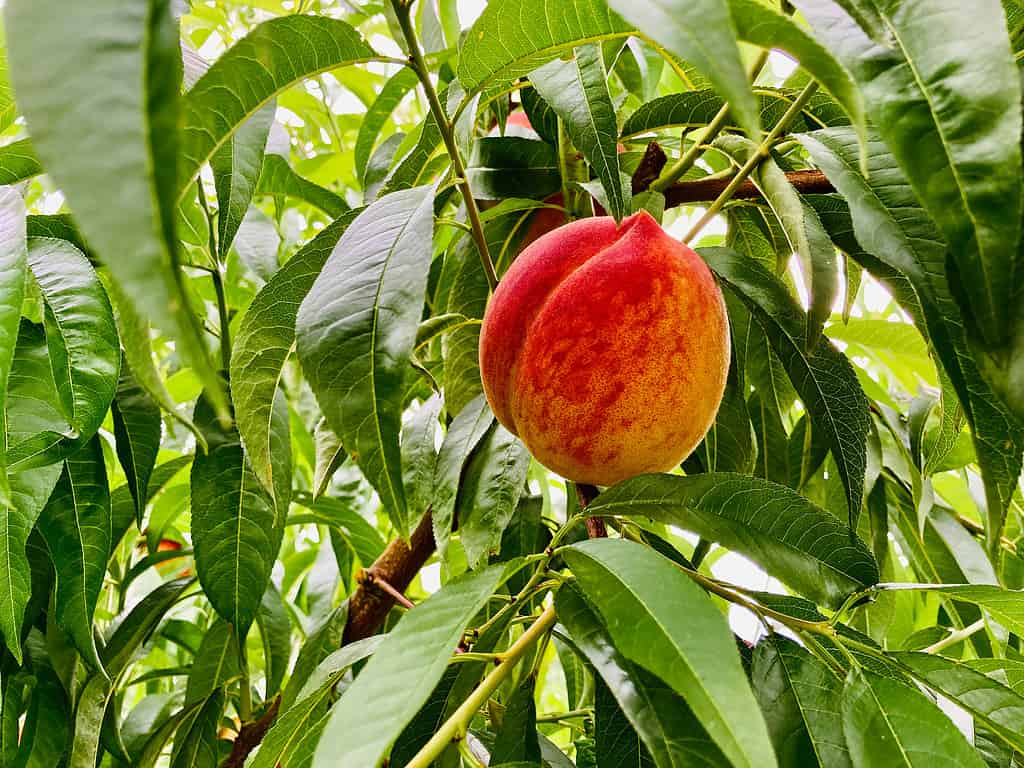
Ripe peaches no longer have a greenish tint on their skin. Many varieties develop a red blush over yellow backgrounds when they are ripe.
©Zdena Venclik/Shutterstock.com
How do you know when peaches are ripe?
Harvesting peaches at the right time ensures the best flavor, juiciness, and sweetness. Of course, the time of year matters since Georgia peaches ripen in the summertime. Then firmness, color, scent, and taste are the main factors determining when peaches are perfectly ripe.
Keep the following factors in mind when you next pick some peak-season fruit from a Georgia peach tree:
- Firmness: Gently squeeze the peach near the top of the fruit to see if it has a slight amount of give. That’s the ideal firmness of a ripe peach. If the fruit is completely firm with no give to its flesh, it’s not ripe yet. And if the peach is mushy, it’s probably overripe.
- Color: Check the peach skin for signs of a greenish tint, which indicates it’s not ripe yet. The fruit is ready to pick when any green tones are gone, and its skin has a vibrant, rich color. Leave any greenish-toned fruit on the tree to continue to ripen.
- Scent: Smell the peach, though it might gift you with its enticing aroma before you even get near enough to pluck it from a branch. Ripe peaches have a sweet smell when they are fully mature and ready to eat.
- Taste: When in doubt, pick a peach that looks ripe and take a bite. The taste is the ultimate confirmation of ripeness. A perfectly ripe peach will have the ultimate balance of sweetness and acidity with juicy, tender flesh. If the peach you test tastes slightly tart or isn’t very sweet, the other peaches on the same tree may need a bit more time to fully mature.
Depending on the variety, it’s common for the peaches on one tree to ripen at different times. So gently test each peach before picking.
When you do pick a peach, gently twist it off the branch. Or you can give the fruit a slight upward tug until it pulls free. If the peach detaches easily from the stem, it is ripe and ready to go.
Peaches continue to ripen after harvest.
It’s important to note that peaches are climacteric fruit, which means they continue to ripen after harvest. For this reason, experienced peach farmers know to harvest the fruit at just the right firmness, allowing time for sanitation, packing, and shipping before the peach becomes overripe.
Once you bring ripe peaches home, the best way to store them is in the fridge or in a paper bag or a plastic bag with holes. Plastic bags should have holes so the ethylene gas peaches release as they ripen can get through. However, keeping them cool helps peaches last longer.
While peaches stay fresh for a few days in the refrigerator, the best-tasting fruit is the one you eat right away.

A peach is a climacteric fruit that continues to ripen after harvesting.
©BearFotos/Shutterstock.com
How are peaches harvested?
Most Georgia peaches are picked by hand to protect them from damage during harvesting. Handpicking peaches off the tree also allows workers to inspect the fruit before they remove it.
Though each farm or orchard uses its own harvesting system, the peach season in Georgia will often include the following harvesting steps:
- Peaches are handpicked off the tree and might be placed in a large bag worn around the worker’s shoulders.
- Then the peaches go into wheeled containers that tractors pull through each row of peach trees.
- Once the containers are full, they are probably taken directly to an on-site packinghouse for processing.
- The next steps to processing peaches include transferring them onto a machine that moves them through the washing, hand sorting, waxing, labeling, and packing stages. Workers on the packing line supervise these stages.
- Boxes of peaches are checked by quality control workers, then loaded onto pallets. These pallets wait in cold storage until shipped to their final destination.
While on the packing line, peaches are sorted by size. This sorting process helps ensure that peaches similar in size go in the same box.
Many automated systems and machinery have become more popular for peach season in Georgia and other states. These innovative tools, such as mechanical tree shakers and robotic harvesters, can increase harvest productivity. However, manual hand harvesting is still the preferred method in most peach orchards as new technology is gaining popularity.

Freestone is a type of peach that has an easy-to-remove center stone.
©Anna Kucherova/Shutterstock.com
The Three Main Types of Peaches
Knowing when to pick the juiciest peaches depends on which varieties you grow. And it’s important to know what category each peach belongs to.
Clingstone, semi-cling, and freestone are the three main peach categories used to describe the fruit.
- Clingstone peaches: A clingstone peach is usually smaller, very sweet, and very juicy. The flesh of the clingstone peach is also difficult to separate from the center stone (pit). In other words, the flesh “clings” to the stone. Some clingstone peaches are white, and others are yellow.
- Freestone peaches: A freestone peach is the easiest one to eat from your hand because the stone inside is easy to pull from the flesh. These are usually the largest peaches and often ripen mid-season.
- Semi-cling or semi-freestone peaches: The semi-cling (or semi-freestone) peach is a hybrid that’s as sweet as a clingstone peach but with a stone that’s easier to remove. Currently, fewer semi-cling peaches are available compared to clingstone and freestone fruit.
Many peach varieties fall into each of these main categories, and they ripen at various times during peach season in Georgia.
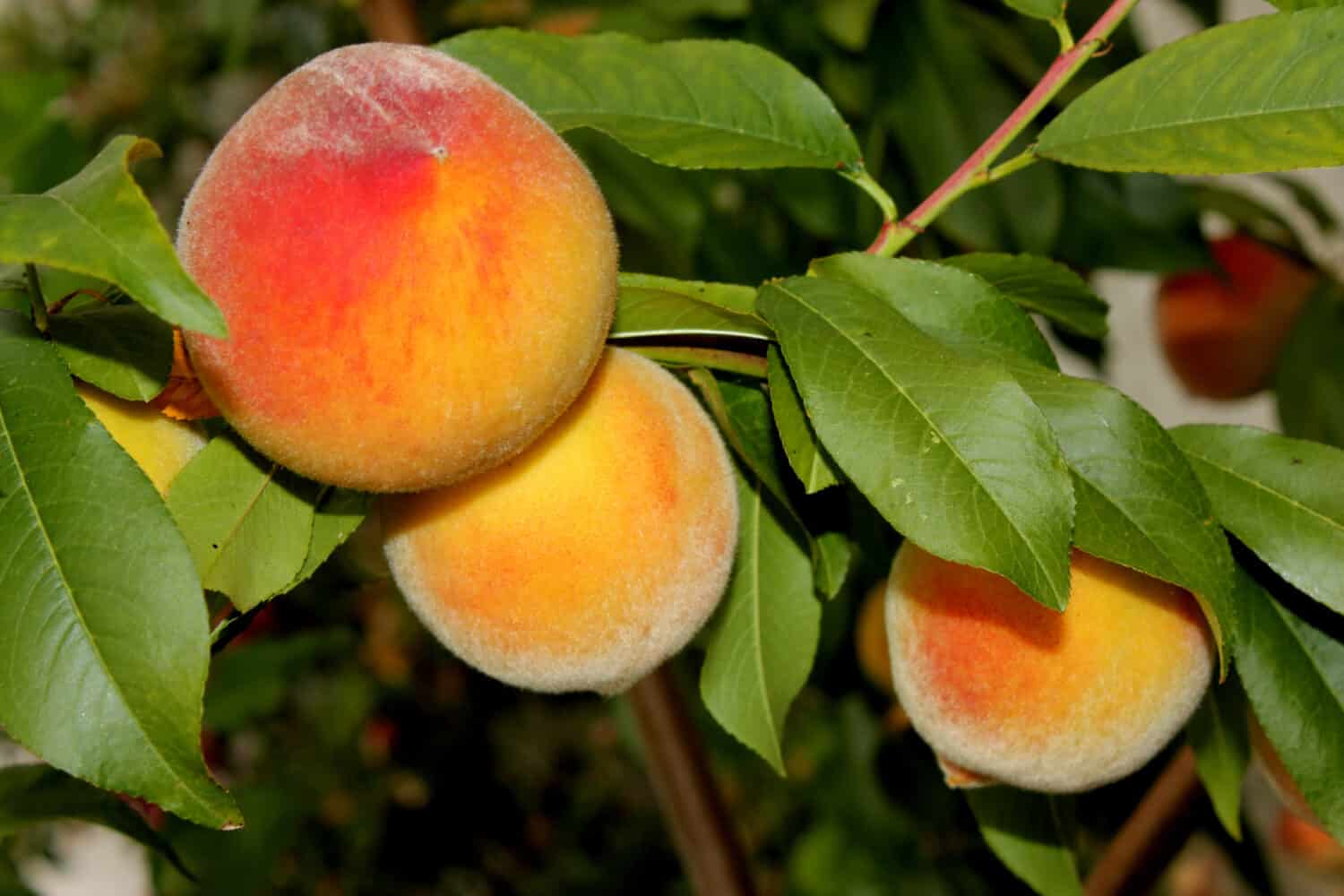
The Elberta peach (
Prunus persica‘Elberta’) is one of the most popular varieties.
©Gurcharan Singh/Shutterstock.com
What are the best peaches to grow?
Successfully growing peaches begins with a hardy and delicious variety. Peach season in Georgia produces many varieties, including a highly popular heirloom fruit called Elberta. But each peach has its own distinct flavor, size, and texture. See the table below for some of the peach varieties in Georgia, plus their characteristics and uses.
| Peach Variety | Type | Characteristics | Uses |
|---|---|---|---|
| Elberta (Prunus persica ‘Elberta’) | Freestone | Yellow skin with a red blush, excellent flavor, ripe in midseason | Great for canning and eating fresh |
| Redskin (P. persica ‘Redskin’) | Freestone | Yellow skin with a red blush, very good flavor, ripe in midseason | Great for freezing and canning, plus eating fresh |
| Arctic Supreme (P. persica ‘Arctic Supreme’) | Clingstone | White skin with a reddish blush, excellent flavor, ripe in mid to late season, self-pollinating | Great for canning and eating fresh |
| Sun Haven (P. persica ‘Sun Haven’) | Clingstone | Yellow skin with a red blush, very good flavor, ripe in mid to late season | A great peach for pies because the flesh doesn’t brown easily |
| Red Haven (P. persica ‘Red Haven’) | Semi-freestone | Yellow skin with a red blush, excellent flavor, ripe early to midseason | A great peach for eating fresh or using in pies since the flesh doesn’t brown easily |
| Flavorich (P. persica ‘Flavorich’) | Clingstone | Yellow skin with a red blush, excellent flavor, ripe early to midseason | Multi-purpose peach for pickling, canning, freezing, baking, and eating fresh |
| Belle of Georgia (P. persica ‘Belle of Georgia’) | Freestone | White skin with a red blush, white flesh, excellent flavor, ripe in late season | Great for canning, baking, and eating fresh |
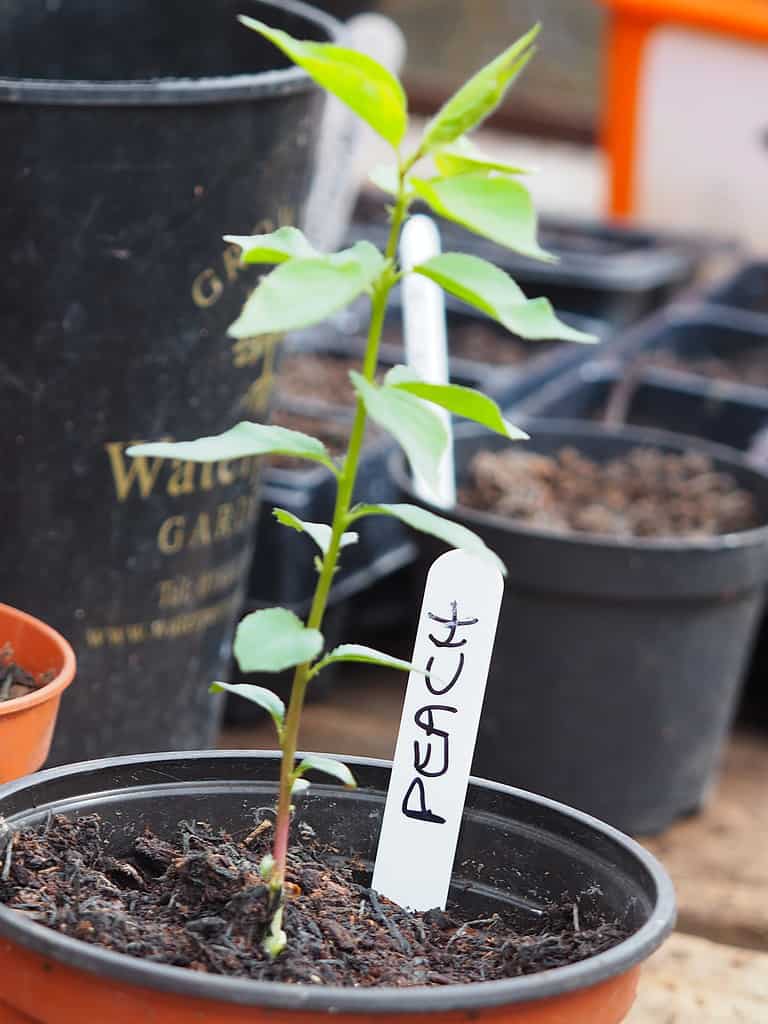
Peach trees thrive in Georgia’s warm climate and nutrient-rich soil.
©Lacey Dent/Shutterstock.com
Why do peaches grow so well in Georgia?
It’s no exaggeration to say that Georgia is a paradise for peach trees because of its ideal climate and soil conditions. Georgia’s mild winters and not-too-humid summers create the kind of climate balance peach trees adore. Additionally, Georgia peach farms have nutrient-rich soil with ideal drainage, perfect for peach tree cultivation.
The juiciest harvest is a peach season tradition in Georgia.
The height of the peach season in Georgia is a time of excitement as the sweet fruit reaches peak ripeness. The peak season for peach picking in Georgia is between mid-May and the end of August. Yet much more goes into the juiciest harvest, including a balance of tradition and modern technology. As the Georgia peach industry evolves, one tradition remains the same: the finest, juiciest peaches are the top priority every year.
The photo featured at the top of this post is © Crisp0022/Shutterstock.com
Thank you for reading! Have some feedback for us? Contact the AZ Animals editorial team.







